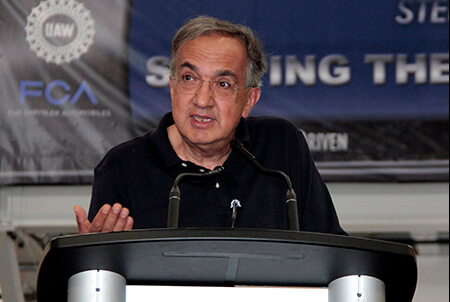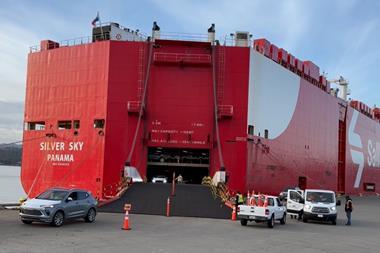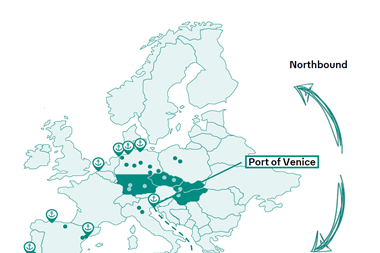 Sergio Marchionne (pictured), former CEO at Fiat Chrysler Automobiles (FCA), was a remarkable man. He frequently dominated the automotive industry’s headlines and news agenda over the last decade or so and his recent passing away robs the industry of one of its few stars. In an age when corporate suits populate so many of the sector’s boardrooms, Marchionne’s more casual dress sense and chain-smoking, espresso-drinking, sleep-on-a-plane lifestyle was unusual. But it worked for him – and also for FCA.
Sergio Marchionne (pictured), former CEO at Fiat Chrysler Automobiles (FCA), was a remarkable man. He frequently dominated the automotive industry’s headlines and news agenda over the last decade or so and his recent passing away robs the industry of one of its few stars. In an age when corporate suits populate so many of the sector’s boardrooms, Marchionne’s more casual dress sense and chain-smoking, espresso-drinking, sleep-on-a-plane lifestyle was unusual. But it worked for him – and also for FCA.
Marchionne oversaw the transformation of both Fiat and Chrysler from loss-making entities with a declining presence in their home markets to a merged entity which – while it still faces many challenges – can report strong financials, and a product strategy that focuses on growing the premium brands in the group.
It is somewhat ironic that his passing away coincides with the next stage of an evolving FCA strategy that will see the Fiat and Chrysler brands both play much diminished roles. The Chrysler brand itself may well have disappeared in a few years, along Lancia, Dodge and a host of other automotive brands that have fallen by the wayside as other companies – GM especially – have thinned down their offerings.
Marchionne’s last public appearance was in June when, along with his hand-picked management team, he presented the next FCA strategic plan to investors and the press. A significant expansion of Jeep was outlined, including the addition of two more models for European, production; as well as a new route for Alfa Romeo to reach a long-held ambition of 400,000 units a year; a plan for Maserati to grow to 100,000 (helped by sharing platforms with Alfa); and the introduction of a wider model range at Ram.
Limited information was provided on the Fiat brand, however, other than that it would finally stop making the Punto later this year and that the Tipo (made in Turkey by Fiat’s affiliate Tofas) would not be re-engineered to take new Euro-6 compliant engines; the Tipo will continue to be sold in countries with less strict emissions rules than the EU, however.
[mpu_ad]Fiat will become a city car brand, centring on the 500 and variants as well as the Panda. Its light commercial vehicle range will be retained, but the days of the Fiat brand competing in the volume market in Europe, at least, appear to be over. It will continue in South America, where by dint of history it has a major presence and profits have come in the past. It may be retrenching in Europe, but FCA does not want to give up on the potential of South America just yet.
Marchionne’s passing-away means that a number of his protégés – especially Mike Manley, the new CEO – have had potential greatness thrust upon them rather earlier than they might otherwise have expected. Manley previously ran Jeep and Ram, and having transformed Jeep from a marginal, 300,000 unit-a-year player into a market leader with close to 1.5m in annual sales, he impressed shareholders at the Q1 results presentation, which he had to front just hours after learning of Marchionne’s death.
There is a lot of difference between presenting the latest financial results and running the business, of course, but after a decade or more working for the master and running two of the most significant brands in the group, Manley hardly comes to the job unaware of what is involved.
The road aheadIt will be interesting to see where FCA goes from here, therefore. Manley and his colleagues will have a honeymoon period, of course, and will also look to see through the plan which Marchionne outlined in June. They were very much part of its development and are unlikely to want to deviate too far from it, at least initially.
However, for all the shine Marchionne brought to FCA and its various strategic plans, questions still remain. From a European perspective, the most notable of these is whether reducing Fiat to a city brand in cars, focused only on the 500 family and the Panda, is really viable. Some think it needs a wider range to be a success.

There is also the question of how the latest incarnation of the plan to get Alfa Romeo to 400,000 units a year will work when previous plans have failed so dismally.
FCA is also well behind its rivals in the race to go electric. Its plans include numerous electric and hybrid vehicles. But they will need to be launched successfully on time. If they are not, FCA will be in severe difficulty, not least because of the still disparate nature of the brand and platforms that underpin the group’s model line-up.
Where VW, with its MQB and other lower volume platforms, has put in place a structure that clearly spreads across the multiple brands and Renault-Nissan is doing much the same with its CMF-A/B/C-D strategy, the same is not really true for FCA. The small car platform used for the 500/Panda will have just one model shared with the rest of the group (the Jeep Renegade) and no other commonality. While shared technology between Alfa and Jeep is beginning, it is still very limited. And while Jeep has the makings of a global brand, it is not clear that the others do: Fiat will have very different market positions and profiles in Europe, South America and other, emerging markets that will be served from its Turkish affiliate; Alfa is still a niche brand focused on Europe, albeit with global pretensions but few sales outside its home market.
All in all, there is clearly much for Mike Manley and his team to do to make Sergio Marchionne’s visions and plans a success. They may succeed, but with the global trading system under threat from the US president’s battles with Europe and China, the FCA strategy may fall foul of changing winds it cannot control.
Fiat Chrysler Automobiles has always seemed an odd alliance to some and its break-up one day – with the prizes of Jeep, Maserati and Alfa ending up in other corporate hands – still appears far from unlikely.



































